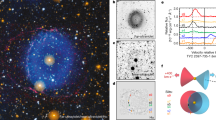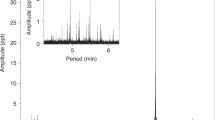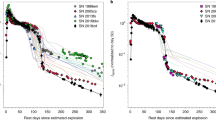Abstract
Arising from: S. R. Kulkarni et al. Nature 447, 458–460 (2007)10.1038/nature05822
An anomalous transient in the early Hubble-type (S0) galaxy Messier 85 (M85) in the Virgo cluster was discovered by Kulkarni et al.1 on 7 January 2006 that had very low luminosity (peak absolute R-band magnitude MR of about -12) that was constant over more than 80 days, red colour and narrow spectral lines, which seem inconsistent with those observed in any known class of transient events. Kulkarni et al.1 suggest an exotic stellar merger as the possible origin. An alternative explanation is that the transient in M85 was a type II-plateau supernova of extremely low luminosity, exploding in a lenticular galaxy with residual star-forming activity. This intriguing transient might be the faintest supernova that has ever been discovered.
This is a preview of subscription content, access via your institution
Access options
Subscribe to this journal
Receive 51 print issues and online access
$199.00 per year
only $3.90 per issue
Buy this article
- Purchase on Springer Link
- Instant access to full article PDF
Prices may be subject to local taxes which are calculated during checkout


Similar content being viewed by others
References
Kulkarni, S. R. et al. An unusually brilliant transient in the galaxy Messier 85. Nature 447, 458–460 (2007)
Rau, A., Kulkarni, S. R., Ofek, E. O. & Yan, L. Spitzer observations of the new luminous red nova M85 OT2006–1. Astrophys. J. 659, 1536–1540 (2007)
Turatto, M. et al. The peculiar type II supernova 1997D: a case for a very low 56Ni mass. Astrophys. J. 498, L129–L133 (1998)
Pastorello, A. et al. Low-luminosity type II supernovae: spectroscopic and photometric evolution. Mon. Not. R. Astron. Soc. 347, 74–94 (2004)
Zampieri, L. et al. Peculiar, low-luminosity type II supernovae: low-energy explosions in massive progenitors? Mon. Not. R. Astron. Soc. 338, 711–716 (2003)
Pastorello, A. et al. SN 2005cs in M51—I. The first month of evolution of a subluminous SN II plateau. Mon. Not. R. Astron. Soc. 370, 1752–1762 (2006)
Chugai, N. N. & Utrobin, V. P. The nature of SN 1997D: low-mass progenitor and weak explosion. Astron. Astrophys. 354, 557–566 (2000)
Maund, J. R., Smartt, S. J. & Danziger, I. J. The progenitor of SN 2005cs in the Whirlpool galaxy. Mon. Not. R. Astron. Soc. 364, L33–L37 (2005)
Li, W. et al. Identification of the red supergiant progenitor of supernova 2005cs: do the progenitors of type II-P supernovae have low mass? Astrophys. J. 641, 1060–1070 (2006)
Kitaura, F. S., Janka, H.-T. & Hillebrandt, W. Explosions of O-Ne-Mg cores, the Crab supernova, and subluminous type II-P supernovae. Astron. Astrophys. 450, 345–350 (2006)
The Padova-Asiago Supernova Catalogue. 〈http://web.pd.astro.it/supern/〉
Della Valle, M. et al. Why are radio galaxies prolific producers of type Ia supernovae? Astrophys. J. 629, 750–756 (2005)
Fisher, D. Kinematic profiles of SO galaxies. Astron. J. 113, 950–974 (1997)
Leitherer, C. Starburst99: synthesis models for galaxies with active star formation. Astrophys. J. Suppl. Ser. 123, 3–40 (1999)
Tonry, J. L. et al. The SBF survey of galaxy distances. IV. SBF magnitudes, colors, and distances. Astrophys. J. 546, 681–693 (2001)
Author information
Authors and Affiliations
Rights and permissions
About this article
Cite this article
Pastorello, A., Valle, M., Smartt, S. et al. A very faint core-collapse supernova in M85. Nature 449, E1–E2 (2007). https://doi.org/10.1038/nature06282
Received:
Accepted:
Issue Date:
DOI: https://doi.org/10.1038/nature06282
Comments
By submitting a comment you agree to abide by our Terms and Community Guidelines. If you find something abusive or that does not comply with our terms or guidelines please flag it as inappropriate.



